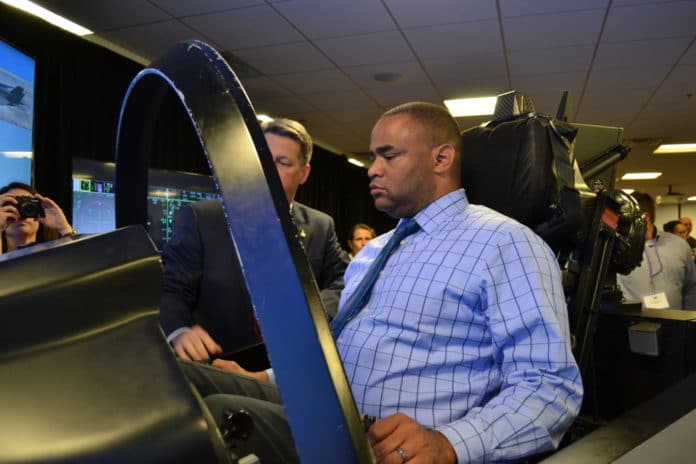Rep. Marc Veasey (D-Fort Worth) climbed into the cockpit of an F-35 Lightning II fighter jet, placed his hands on the controls and prepared for takeoff — well, a simulated takeoff, that is.
Veasey, along with other government leaders like Arlington Mayor Jeff Williams and Fort Worth City Councilman Cary Moon, were in Arlington on July 20 to hear an update on the F-35’s production status and also get a chance to test the cockpit simulator. The event took place at aviation manufacturer Triumph Group Inc.’s Aerospace Structures facility. Triumph Group, Inc., supplies several structural and system components for the F-35 like hydraulic valves and drag chute actuators. Lockheed Martin is building the plane in its Fort Worth plant. On July 8, Triumph Group was selected by Lockheed Martin to supply key engine and structures components for the F-35 Lightning II aircraft.
Triumph Group trades under the TGI symbol on the NYSE.
Veasey said he’s been in a cockpit before, but what he likes about the F-35 is its improved technological capabilities, compared to the jet’s older counterpart, the F-16. The F-35 is equipped with software, information gathering and sharing technology as well as enhanced stealth capabilities among other features. Pilots can also customize what they see on screen, similar to how one would customize a smartphone or computer.
“Just seeing what the plane can do, particularly seeing the range that the plane has, I think that’s really the most important thing for people to understand when they talk about the difference between the F-16 and the F-35,” Veasey said. “This plane has the capacity to perform certain functions, certain offensive functions, and defensive for that matter, from such a longer distance than anything we have right now.”
Lockheed has been working on the F-35 since 2001, building the aircraft for the U.S. Air Force, Navy, Marine Corps and international allies like Norway and Israel. The estimated cost of the project is nearly $400 billion.
Veasey said increasing production of the aircraft in the coming years will help keep the cost down and give the U.S. an edge in aerial warfare.
“Sometimes I think that this gets lost, that we continue to increase production at the necessary rate to reach full production capacity in fiscal year 2018,” he said. “The rapidly advancing threats around the globe will make a strong case for significantly increasing F-35 production to ensure the services have the fifth generation inventory required to ensure air superiority in the mid-2020s.”
The F-35 is currently working its way through the branches of the U.S. military to be declared ready for limited combat operations, a status known as “initial operating capability” (IOC). The U.S. Marine Corps declared IOC in July 2015, and the U.S. Air Force is expected to declare IOC later this year.
Even with IOC, the plane could be ready for combat as is, according to Air Force Gen. Herbert ‘Hawk’ Carlisle, the head of Air Combat Command responsible for deeming the plane combat ready. He said on July 13 that once IOC is declared, the plane could be deployed for combat missions if needed.
The Navy is expected to declare IOC by 2018, said Eric Van Camp, F-35 business development director at Lockheed Martin.
www.triumphgroup.com/






